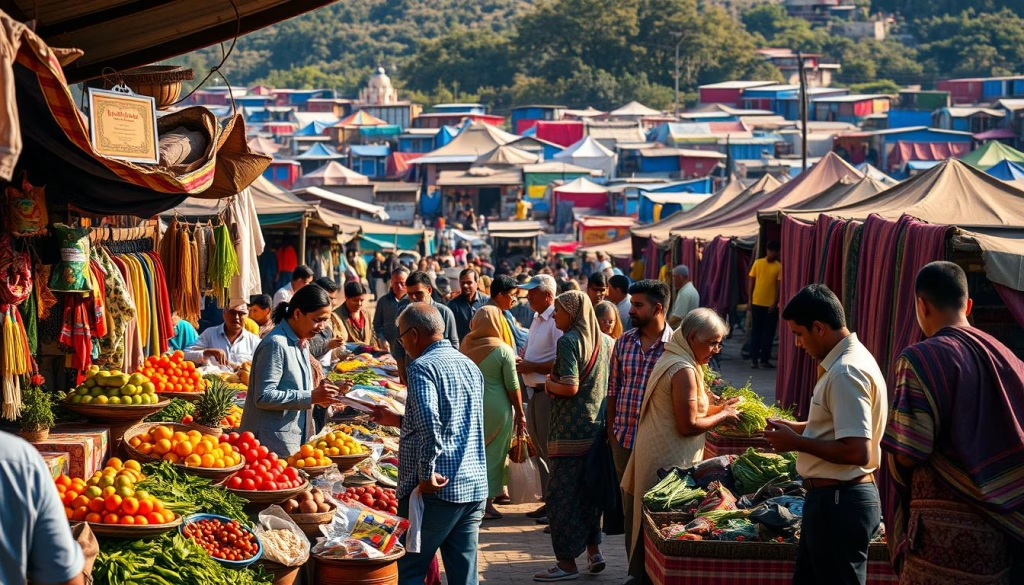In today’s world, the exchange of goods is key to trading and global commerce. This guide will show how goods exchange is important in international trade. We’ll look at definitions, how it works, cultural aspects, and legal rules.
Understanding the Concept of Exchange of Goods
The exchange of goods is key to our economy. We need to look at what goods are, the different types, and the history of trading them. Each part helps us see how goods move in markets and affect our lives.
Definition of Goods
Goods are things we can buy or sell. This idea is at the heart of trade and commerce. It’s vital for understanding how markets work, both near and far.
Types of Goods
Goods can be grouped into several types, each with its own role. The main types are:
- Consumer goods
- Capital goods
- Durable goods
- Non-durable goods
Knowing these types helps us see their role in our lives and the economy.
History of Goods Exchange
The history of trading goods is both interesting and long. It started with bartering, where people swapped goods without money. As societies grew, money was invented, changing trade forever. Now, digital platforms make trading easier, showing how connected our world is.
The Importance of Goods Exchange in Trade
The exchange of goods is key to our economies and global trade. It shapes our world and connects us all. Let’s see how it impacts our economies and ties us together.
Role in Economic Development
Goods exchange is vital for economic growth. It lets countries use their strengths to their fullest. Nations with strong trade see:
- More economic growth by reaching bigger markets.
- More jobs as businesses grow and offer more products.
- Less poverty, as trade opens up new chances in many fields.
By focusing on what they do best, countries can work smarter. This exchange is the backbone of a thriving society.
Global Trade and Economic Relations
Trading goods helps nations build strong bonds. It leads to teamwork in making trade deals and setting tariffs. This is key for a stable global market. Good trade exchange lets us:
- Strengthen partnerships through better trade links.
- Have deeper talks on big issues in international relations.
- Support economic unity, leading to shared growth and stability.
The Mechanisms of Goods Exchange
Goods exchange uses different methods, like the barter system, money, and digital platforms. Each has its own benefits and challenges. This makes the market complex.
Barter System
The barter system is the oldest way of trading. People swap goods without using money. It’s not as common today because it’s hard to find someone who wants what you have.
Money and Currency Exchange
Money made trading easier and more flexible. Currency exchange is key in international trade. It affects prices and market trends. Knowing how currencies change can help in making smart trading choices.
Digital Platforms for Exchange
Digital trading platforms have changed how we trade. They make transactions smooth and open up global markets. E-commerce is changing old trading ways, giving businesses new chances to grow.
Legal Framework Surrounding Goods Exchange
It’s vital to know the legal rules for trading goods across borders. Trade laws, international deals, and import rules make a clear path for businesses. This setup helps follow rules and makes trading between countries easier.
International Trade Laws
Following international trade laws is key for businesses. These laws cover things like tariffs, quotas, and trade limits. Knowing these laws helps us stay legal when trading goods.
Trade Agreements
Trade agreements, like the USMCA, are important for global trade. They set rules for tariffs and market access. Knowing these agreements helps us use them to our advantage when trading.
Import and Export Regulations
Import and export rules are set by governments. They decide what can come in and go out. Following these rules keeps our interests safe and makes trading smoother.
Logistics and Supply Chain in Goods Exchange
In the world of goods exchange, logistics is key. It makes sure products arrive on time. Knowing about logistics and supply chain helps us work better and save money.
Transport Methods
Choosing the right transport is vital for good logistics. Air, sea, and rail each have their own benefits. For example, air freight is fast for urgent items, while sea freight is cheaper for lots of goods.
Knowing these options helps businesses plan better. They can make their logistics work more smoothly.
Inventory Management
Managing inventory well is important in supply chain management. It helps businesses match stock levels with demand. Using Just-In-Time (JIT) helps avoid too much stock while keeping enough for customers.
This way, we use our resources better. It makes our supply chain leaner and more ready to respond.
Distribution Networks
The way goods are distributed affects how they reach customers. Networks vary by region, impacting trade. A good network ensures goods are delivered on time, making customers happy.
Understanding regional differences helps us plan better. We can meet market needs more effectively.
Impact of Technology on Goods Exchange
In recent years, technology has changed how we trade goods. E-commerce has become a key player, changing old marketplaces. It lets businesses talk to customers worldwide easily.
This digital world makes things more accessible. It also brings more products to customers, often at good prices.
E-commerce Developments
E-commerce has changed how we track and trade goods. Sites like Amazon and eBay connect buyers and sellers globally. This has opened up new markets for small businesses.
It lets them reach more customers. This change helps businesses meet consumer needs faster and adapt to new trends.
Blockchain and Goods Tracking
Blockchain technology is also making a big impact. It makes data safer and more open, helping track goods better. With blockchain, we can follow products from start to end.
This stops fake products and builds trust. It also makes trading more honest and reliable.
Cultural Considerations in Goods Exchange
In global commerce, knowing about cultural differences is key. Our trade must show cultural sensitivity. This means we respect the diverse backgrounds that shape business relationships.
Misunderstandings from cultural gaps can harm negotiations. They might even break off promising partnerships. By valuing these differences, we can build stronger international connections.
Cultural Sensitivity in Trade
Cultural sensitivity means understanding and valuing different cultures in trade. It helps us avoid mistakes that could hurt our chances. For example, knowing local customs helps us present our products better.
Being adaptable builds stronger relationships. It opens doors for working together.
Ethical Trading Practices
Ethical trading is vital today. Customers want to know their purchases don’t support unfair practices. By choosing ethical trading, we ensure fair treatment for everyone involved.
This approach boosts our reputation. It also meets the growing need for honesty in global trade.
Challenges and Risks in Goods Exchange
When we deal with goods exchange, we face many challenges and risks. Knowing about these helps us find ways to reduce their impact.
Trade Barriers
Trade barriers like tariffs, quotas, and strict rules can block the flow of goods. They can make products more expensive and harder to find abroad. Businesses must understand these barriers and plan their trade strategies carefully to stay competitive.
Currency Fluctuations
Currency risk comes from changes in exchange rates, affecting our profits in international trade. Unexpected changes in currency values can cause costs or losses. To protect our finances, we should use strategies like hedging and diversifying our currency to manage these risks.
Political Instability
Political factors can greatly affect our ability to trade goods smoothly. Changes in government, sanctions, or unrest can harm trade relationships and supply chains. It’s important to keep up with global politics and check how they might affect our trading.
Sustainability and Goods Exchange
Global trade is complex, and sustainability is key. The impact of goods trade goes beyond just the deal. It affects huge ecosystems and communities. We must face these challenges and work to improve our trade ways.
Environmental Impact of Goods Trade
Goods trade has a big environmental cost. Things like transport emissions, using up resources, and making waste are big issues. For example, shipping goods far away means a lot of carbon emissions.
We need to understand how our trade harms the climate. We should push for ways to lessen these bad effects.
Sustainable Practices
Using sustainable trade practices helps the planet and our image. It shows we care about the environment. By doing things like:
- Reducing packaging waste
- Sourcing materials ethically
- Optimising transportation routes
we show we’re serious about being green. Choosing partners who care about the planet helps us all. This way, we meet the needs of a market that cares about the environment.
The Future of Goods Exchange
The world of goods exchange is always changing. This is thanks to new global trends and trade innovations. As we look ahead, changes in how people shop and tech advancements will shape our strategies.
Trends in Global Trade
Today’s global trends are changing how we trade. Key changes include:
- The rise of digital currencies, opening up new ways to pay.
- More people want to see how goods are made and where they come from.
- There’s a growing push for sustainable practices, making us think about the planet.
By understanding these trends, businesses can stay ahead and thrive in a changing world.
Innovations Driving Change
Trade innovations are key to changing goods exchange. Technologies like:
- Artificial intelligence in supply chains, making decisions faster.
- Automated customer service, making shopping better.
- Blockchain for safe and clear transactions, building trust.
These innovations aim to make trading smoother and more successful, leading to a bright future.
Case Studies in Successful Goods Exchange
Looking at case studies of successful goods exchange gives us valuable insights. It shows us how different sectors use effective trade practices. These examples highlight innovative strategies that help businesses grow, even in tough international markets.
Examples from Different Industries
Many case studies show us different successful trade practices. Here are some key examples:
- Agriculture: The Fairtrade system has changed how we trade commodities. It makes sure producers get fair pay. This approach supports sustainability and meets consumer needs.
- Technology: Companies like Apple manage their global supply chains well. They use local parts but keep quality high. This strategy boosts efficiency and market reach.
- Fashion: Brands like Zara quickly respond to trends with smart inventory management. They can change their products fast based on what customers want.
Lessons Learned
Every case study teaches us something important. By learning from others’ successes and challenges, we can improve our own trade strategies. Key lessons include:
- Being adaptable is key. Businesses that adjust to market changes often do better than others.
- Strong partnerships improve supply chain reliability. This helps both sides grow together.
- Regularly checking and using feedback is vital for keeping trade practices successful.
The Role of Consumers in Goods Exchange
Consumers play a big role in how goods are exchanged. Their likes and actions shape the market. When their tastes change, businesses adjust by changing what they sell and how they market it.
More people want goods that are good for the planet and made fairly. Knowing what consumers want helps us understand trade better.
Consumer Behaviour
Our view of what drives consumer behaviour has grown. People choose based on many things, like the brand’s reputation and quality. Today, many are ready to switch brands for ethical reasons.
This change brings both challenges and chances for companies. They must meet new demands while staying true to values.
Ethical Consumption
Ethical consumerism is on the rise. It shows people care more about social and environmental issues. Many look for companies that focus on fair trade and sustainable practices.
This choice affects trade. It pushes businesses to align with what consumers value. By making smart choices, we help demand goods that are good for everyone and the planet.
Conclusion: The Endless Cycle of Exchange
Trade is a journey of change and adaptation. It’s shaped by new tech, economic shifts, and changing needs. This mix of factors brings both chances and challenges for traders in the global market.
The Continuous Evolution
Looking back, we see how these changes create new paths for trade. It’s vital to keep up with innovation and follow ethical, sustainable practices. In this fast-changing world, being adaptable is key. We must adjust our trading plans as new trends come along.
Future Prospects for Goods Exchange
Our view on the future of goods exchange is hopeful. The growth is promising, thanks to digital platforms that make buying and selling easy. Sustainability will play a big role, as we focus on ethical buying in our connected world. Embracing these changes will help us stay ahead in the trade world.











